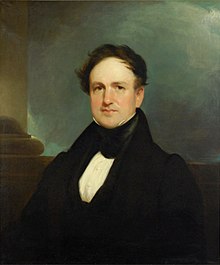| Benjamin Chew Howard | |
|---|---|
 portrait by Henry Inman portrait by Henry Inman | |
| Born | 5 November 1791 Baltimore County |
| Died | 6 March 1872 Baltimore |
| Alma mater | |
| Occupation | Politician, lawyer |
| Spouse(s) | Jane Gilmor Howard |
| Parent(s) | |
| Family | George Howard |
| Position held | united States Representative (1829–1831), member of the Maryland House of Delegates |
Benjamin Chew Howard (November 5, 1791 – March 6, 1872) was a Maryland politician and lawyer. After serving on the city council of Baltimore in 1820 and in both houses of the Maryland legislature, he was a Representative in the United States Congress from 1829 to 1833, and from 1835 to 1839. He was thereafter the fifth reporter of decisions of the United States Supreme Court, serving from 1843 to 1860.
Early life and education
Howard was born at Belvidere in Baltimore County, Maryland, the son of John Eager Howard and Margaret ("Peggy") Chew, daughter of Benjamin Chew. He received an A.B. from Princeton University in 1809. In 1812 he attended and graduated from Litchfield Law School in Connecticut.
War of 1812
During 1814, the last year of the War of 1812 he served as a Captain in the First Mechanical Volunteers, a company of the 5th Maryland Regiment at the Battle of North Point. The battle would become the turning point of the War. He remained in the service and later he reached the rank of brigadier general in the Maryland militia.
Marriage and family

Among his siblings were George Howard, Governor of Maryland; Dr. William Howard, a civil engineer and architect; and Charles who with his son Francis Key Howard, were imprisoned in Fort McHenry at the start of the American Civil War. In 1818 he married Jane Gilmor who would write a charity cookbook and after the Civil War lead a successful fundraising fair. They had twelve children.
Political life
A Democrat, he served on the city council of Baltimore in 1820 and in both houses of the Maryland legislature. He was elected to the Twenty-first and Twenty-second United States Congress, serving from March 4, 1829 to March 3, 1833. In 1835, President Andrew Jackson named Richard Rush and Howard to arbitrate the Ohio-Michigan boundary dispute.
He returned to Congress in the Twenty-fourth Congress and was re-elected to the Twenty-fifth, serving from March 4, 1835, to March 3, 1839. During this service, he chaired the House Foreign Relations Committee for four years.
In 1861, he was one of the emissaries sent by outgoing President James Buchanan to try to secure a peace with the Confederacy. That year he unsuccessfully ran for Governor of Maryland. He died in Baltimore at his home on March 6, 1872 and is buried in Greenmount Cemetery.
United States Reports
Starting with the 42nd volume of United States Reports, Howard was the Reporter of Decisions of the Supreme Court of the United States, serving from 1843 to 1860. His term covered volumes 42 through 65 of US Reports, corresponding to volumes 1 through 24 of his nominative Howard’s Reports. As such, the dual form of citation to, for example, the Supreme Court decision in Williams v. United States is 42 U.S. (1 How.) 290 (1843).
See also
References
- ^ "Biographical Directory of the United States Congress". Retrieved 25 January 2019.
- ^ Scharf, John Thomas (1874). "Scharf, John Thomas. The Chronicles of Baltimore: Being a Complete History of "Baltimore Town" and Baltimore City. Baltimore: Turnbull Brothers, 1874". Retrieved 25 January 2019.
- "Litchfield Historical Society. Database of Students of the Litchfield Law School". Retrieved 25 January 2019.
- "The Battle of North Point Part 1 - Fort McHenry National Monument and Historic Shrine (U.S. National Park Service)". www.nps.gov. Retrieved 2025-01-08.
- ""Fifty Years in a Maryland Kitchen"...and Belvidere". Researching Food History. 9 June 2014. Retrieved 25 January 2019.
External links
- Works by Benjamin Chew Howard at Project Gutenberg
- Works by or about Benjamin Chew Howard at the Internet Archive
- Benjamin Chew Howard at Find a Grave
| Party political offices | ||
|---|---|---|
| Preceded byJohn C. Groome | Democratic nominee for Governor of Maryland 1861 |
Succeeded byEzekiel F. Chambers |
| U.S. House of Representatives | ||
| Preceded byJohn Barney and Peter Little | Member of the U.S. House of Representatives from Maryland's 5th congressional district 1829–1833 |
Succeeded byIsaac McKim |
| Preceded byJames P. Heath | Member of the U.S. House of Representatives from Maryland's 4th congressional district 1835–1839 |
Succeeded byJames Carroll and Solomon Hillen |
| Legal offices | ||
| Preceded byRichard Peters | United States Supreme Court Reporter of Decisions 1843–1860 |
Succeeded byJeremiah S. Black |
| Taney Court (1836–1864) | |||||||||||||||
|---|---|---|---|---|---|---|---|---|---|---|---|---|---|---|---|
| Justices |  | ||||||||||||||
| Decisions |
| ||||||||||||||
| Statutes | |||||||||||||||
- 1791 births
- 1872 deaths
- United States Army personnel of the War of 1812
- Baltimore City Council members
- Democratic Party Maryland state senators
- Democratic Party members of the Maryland House of Delegates
- Princeton University alumni
- Reporters of Decisions of the Supreme Court of the United States
- American militia generals
- Jacksonian members of the United States House of Representatives from Maryland
- Democratic Party members of the United States House of Representatives from Maryland
- Howard family of Maryland
- Chew family
- 19th-century members of the United States House of Representatives
- 19th-century members of the Maryland General Assembly
